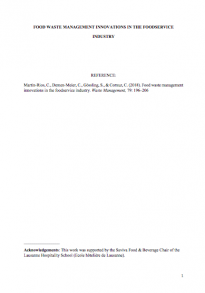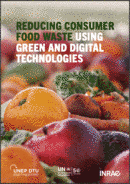Supportive Policy Environment for Restaurants, Catering and Food Service
Recent policy linked research found that many companies are not actively innovating in the waste domain. They are however increasingly aware of the economic and social importance of waste management. Organizations taking waste management seriously might gain significant efficiency by partnering with third-party companies or by borrowing solutions from other industries that can be adapted to food service establishments relatively easily. On the downside, the food service industry is not leading the way when it comes to innovation. As the study shows, there are only a few low- or zero-waste restaurants, and few chefs who are creating meals with food scraps. The research provides managers with a set of tools (i.e., practices from several companies committed to adopting waste initiatives) to deliver a reflection-in-practice approach to waste issues pertaining to food service firms. The lack of clear, common definitions and consistency across studies might be one of the reasons for which the food service sector lags behind other industries when it comes to food waste management. It also calls for tools and concepts to design the innovative practices supporting effective waste management systems. Future research may address such tools and concepts, as well as different types of innovations and sources of co-operation between collaborative firms and traditional food service organizations.
Champions 12.3 Policy Guidance for Reducing Food Loss and Waste
Champions 12.3 provides broad policy guidance for the restaurant and catering sector. For example, managers are encouraged to “target, measure, and act” to realize the business case for themselves.
- Target. Targets set ambition, and ambition motivates action. Restaurants and caterers should adopt a voluntary reduction target of 50 percent by 2030, which is aligned with Target 12.3 of the Sustainable Development Goals.
- Measure. What gets measured gets managed. Restaurants and caterers should start to measure their food loss and waste, and monitor progress toward achieving the target over time. The Food Loss and Waste Accounting and Reporting Standard can help entities proceed with measurement.
- Act. Action is what ultimately matters. Restaurants and caterers—working alone and together—should take measures to reduce food waste. A key success factor for action is management engagement.
Food Donation Potential
Food Donation Potential
Restaurant, catering, and food service management can determine food donation potential by using waste tracking procedures to record and monitor surplus food amounts, focusing on food types and quantities. This monitoring can help identify money saved from potential collection and disposal fees, number of meals saved, and potential tax benefits. Management should take the time to understand tax deductions or incentives available for food donation and can collaborate with food donation organizations. These organizations can aid in the identification of an appropriate food donation recipient based on when and what the restaurant can donate, assist in picking up and transporting the food, help restaurants realize enhanced tax deductions, and ensure the all applicable food safety guidelines are followed in regards to food donation. It should be noted, however, that food donations are not generally a major outlet for fish due to the short shelf life of fresh products.
Policy in Practice: Food Donation Tax Deductions in the U.S.
Policy in Practice: Food Donation Tax Deductions in the U.S.
In the US, tax deductions provide a financial incentive by making food donations more cost effective. Internal Revenue Code 170(e)(3) (the Code) provides enhanced tax deductions to businesses to encourage donations of fit and wholesome food to qualified non-profit organizations serving the poor and needy. The PATH Act, federally known as the 2015 Protecting Americans from Tax Hikes, entitles eligible businesses permanent access to enhanced deductions. A donating business's total annual charitable deductions are capped at different rates, depending on what type of business makes the donation. The enhancements to the deduction help offset some of the costs of labour needed to separate and store food for donation—as well as time spent communicating with food donation organizations.
Key Publications
The Business Case for Reducing Food Loss and Waste: Catering This publication focuses on the financial business case for reducing food loss and waste in the catering sector. | |
Food waste management innovations in the foodservice industry This paper presents multiple waste management initiatives, discusses how implementation in the foodservice sector varies depending on management’s beliefs, knowledge, goals and actions, and highlights factors that drive the adoption of food waste innovations. | |
France moves toward a national policy against food waste The report discusses the idea that food is not a commodity, preventing food waste is high priority – followed by reuse and recycling – and food waste reduction can become a sustainable economic activity. |
More Resources
More Resources
31 October 2023














